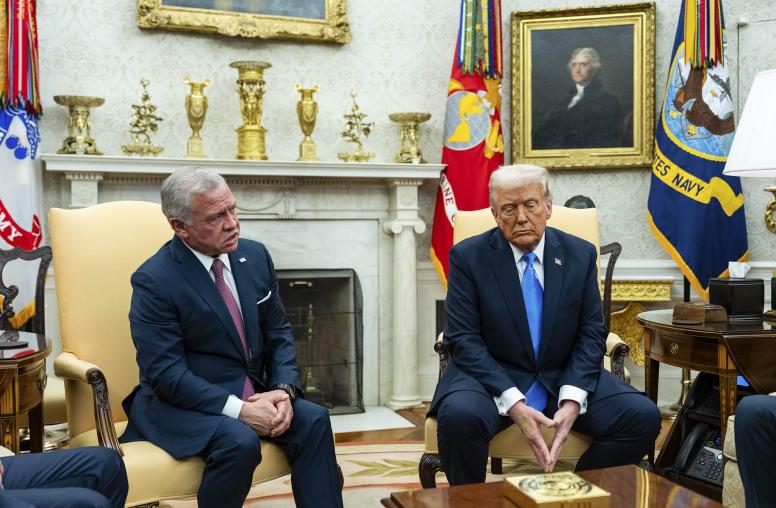The Israeli-Palestinian Standoff: More Risks Emerging
The hobbled Palestinian economy, the weakness of the Fatah-led Palestinian Authority that governs much of the West Bank and the dormancy of the peace process together may be increasing the risk of a deterioration of the conflict and an rise in violence on the West Bank in 2013. USIP’s continuing series on “sleeper risks” takes a closer look at this potentially explosive dynamic.

It’s often said about Israeli-Palestinian peace efforts that if they are not moving f
 Many of the clearest risks of conflict, violence and instability around the world have received widespread media attention. But a variety of other risks and threats have been smoldering quietly. The United States Institute of Peace (USIP) is engaged in a variety of peacebuilding and conflict management efforts in many of the countries where these lesser-known risks are emerging. In a series of articles, the Institute examines some of these “sleeper risks” through the analytical lens of USIP experts. | Read more about USIP’s series on sleeperorward, they are likely to move backwards. The depth of frustration among Palestinians makes the status quo ever unstable, as was tragically apparent during the violent intifadas (or uprisings) of the past. The hobbled Palestinian economy, the weakness of the Fatah-led Palestinian Authority (PA) that governs much of the West Bank and the dormancy of the peace process may together be increasing the risk of a deterioration of the conflict and an increase in violence on the West Bank in 2013 — a dangerous dynamic that is not widely appreciated.
Many of the clearest risks of conflict, violence and instability around the world have received widespread media attention. But a variety of other risks and threats have been smoldering quietly. The United States Institute of Peace (USIP) is engaged in a variety of peacebuilding and conflict management efforts in many of the countries where these lesser-known risks are emerging. In a series of articles, the Institute examines some of these “sleeper risks” through the analytical lens of USIP experts. | Read more about USIP’s series on sleeperorward, they are likely to move backwards. The depth of frustration among Palestinians makes the status quo ever unstable, as was tragically apparent during the violent intifadas (or uprisings) of the past. The hobbled Palestinian economy, the weakness of the Fatah-led Palestinian Authority (PA) that governs much of the West Bank and the dormancy of the peace process may together be increasing the risk of a deterioration of the conflict and an increase in violence on the West Bank in 2013 — a dangerous dynamic that is not widely appreciated.
“Several factors, including in particular the economic crisis that is dramatically weakening the PA, could move the conflict further from resolution if they’re not addressed soon” said Neil Kritz, a Middle East specialist and USIP senior scholar in residence. Kritz also serves as an adviser in the Office of the Quartet Representative, focusing on Palestinian justice issues and facilitating Israeli-Palestinian cooperation in that area. (The Quartet, established to advance the peace process, is comprised of the United States, the European Union, Russia and the United Nations.)
Israel suspended the transfer of tax revenues that it collects on behalf of the PA in reaction to the PA’s successful drive last November to win “non-member observer state” status at the United Nations General Assembly. The U.N. bid was a popular move among Palestinians but it angered the Israeli government, which, with U.S. support, insists that the move violates existing agreements and that statehood status must be the result of a negotiated settlement.
The economic impact of withholding about $100 million a month on an already struggling economy has been harsh. Those transfers represent about one-third of PA monthly expenses, said Palestinian Prime Minister Salam Fayyad, according to an Associated Press report. Fayyad said the fiscal crisis could push 1.5 million of the 4 million Palestinians into poverty.
On January 30, Israel announced that it would transfer one month’s revenue—on a one-time basis—to ease the Palestinian financial crisis, leaving open the question of whether regular monthly transfers would resume. Even with the revenue transfers, however, the PA economy faces severe challenges. Economic growth under Fayyad was strong in 2008-10, but in 2012 growth slowed by almost 40 percent. The government deficit has increased to $1.4 billion. The PA has repeatedly been unable to pay civil servants on time during the past year, prompting a series of two-day strikes in January. Earlier protests over rising food and fuel prices brought Palestinians into the streets last fall. Overall unemployment on the West Bank and in Gaza, according to the World Bank, has climbed above 24 percent, 19 percent on the West Bank itself; youth unemployment on the West Bank is estimated at 26 percent and at 44 percent in Gaza.
By January, many people in the West Bank were not reporting to work due to unpaid salaries and the lack of funding for fuel. The courts introduced a shift system to stagger staff attendance, slowing down judicial procedures. Financial strains also extend to the Palestinian security services, which have been crucial both to maintaining order for Palestinian society and to Palestinian-Israeli cooperation and relative quiet.
Arab League pledges of an aid “safety net” for the Palestinians to cushion the impact of the Israeli suspension of tax transfers have been slow to materialize. Palestinian economic growth is also constrained by Israeli restrictions on movement and investment in much of the West Bank, and the Palestinians have not received all of the donor aid that has been pledged, the World Bank reports.
Kritz notes that the PA budget faces a variety of fundamental challenges beyond the significant issue of tax transfers. One result is to constrict funds available for the provision of social services by the government. About one-third of the PA budget, for example, is devoted to the security sector. And since the West Bank-Gaza split in 2007, the PA has kept on its payroll thousands of Gazan civil servants who have been replaced by the Hamas-run government there; 20 percent of the PA budget is spent on the salaries of these people who stay at home, an arguably unsustainable expense over the long run.
Add to that economic pain the growing West Bank activism of Hamas, the radical Islamist movement that has controlled Gaza since 2006, and you have a deepening fragility of the PA itself. Hamas has managed to pay salaries in Gaza consistently, and has recently attracted significant financial support from Qatar. Its kidnapping of Israeli soldier Gilad Shalit ultimately resulted in the controversial Israeli release of approximately 1,000 Palestinian prisoners, while the more moderate PA has failed to achieve such a release. And following the recent Gaza war, Hamas has received new concessions from Israel, such as a doubling of the fishing limits off the Gaza coast.
Meanwhile, the PA in the West Bank is perceived by many Palestinians as ineffective in its dealings with Israel—both in its inability to prevent continuing Israeli settlement construction and in its efforts to convince Israeli to ease a variety of security-related restrictions. All this has contributed to a weakening of the PA. Reconciliation efforts between the PA and Hamas have recently gained momentum. If they fail once again (as have such attempts in recent years), the internal Palestinian division and frustration may grow; if they succeed in reconciling and forming a joint government, it may result in Israeli, U.S. and possibly European financial cut-offs to the PA, deepening the financial crisis.
Recent economic protests on the West Bank were kept in check. But Kritz is concerned that future ones that start with a focus on frustration with the PA could then take on a strongly anti-Israeli character—and that Israeli concern over increased Hamas activity and support on the West Bank could trigger more incursions by the Israeli Defense Forces.
“Those factors, or an increase in Israeli settler attacks that has been occurring in the last couple of years, or tensions over Israeli settlement construction or the new, bolder Palestinian attempts to oppose construction by setting up their own ‘tent city’ facts on the ground all have the potential to push the conflict into a new negative spiral,” said Kritz. “The grass really has been getting drier, making it easier for any of these sparks to light a fire and have things get out of control.”
If that happens, it would not begin with an armed insurrection, suggests Kritz. On the one hand, 2012 was the first year since 1973 in which no Israeli was killed by a terror attack in the West Bank, according to Israel’s Shin Bet intelligence service; on the other hand, there has been an increase in smaller-scale violence. And the number of Palestinian casualties in the West Bank has also increased, with four Palestinian civilians killed by Israeli security forces in January. “One can feel the temperature rising,” said Kritz.
The temperature could rise further with PA diplomatic actions. Stymied in making economic progress at home and competing with Hamas for popular support, the PA might well play up its nationalist appeal by choosing to campaign for further international recognition and membership in international organizations. Said Kritz, “The PA could decide that it can only make advances on the international front.” Such steps could lead to new Israeli reactions and economic pressure on the West Bank. The potential result: more protests, more violence and more openings for Hamas on the West Bank.
Kritz points to an additional “sleeper” concern over the medium and long term: a hardening of attitudes among the younger generation. “One of the ironies of the Oslo process is that it created separation between the two peoples. While the older generation of Palestinians and Israelis has memories of working or even socializing together pre-Oslo, the younger generation’s knowledge of the other is largely limited to confrontations at military checkpoints,” he said. As a result, support for Palestinian “anti-normalization” efforts, which reject any form of contact with Israelis, is strongest among the younger generation. At the same time, Israelis under 30, according to recent Israeli polling, express much more negative positions vis-à-vis the Palestinians than their elders. “This trend line does not bode well for a protracted status quo,” according to Kritz.
But not all volatility is necessarily negative.
Israeli elections in January produced a result that caught most observers off guard. Attention had focused on the Habayit Hayehudi (“The Jewish Home”) Party, which had campaigned on a platform of opposition to a two-state solution in the Palestinian-Israeli process. Instead, the surprise result was the strong finish of Yair Lapid’s new Yesh Atid (“There is a Future”) Party, which has made a return to the peace process a red-line condition for joining in the new government coalition. “The incoming government to be formed in the coming weeks,” suggests Kritz, “may be in a stronger position to address these emerging risks.”
Explore Further
- USIPs’ work in Israel and the Palestinian Territories
- “The Peace Puzzle” book launch event, America's Quest for Arab-Israeli Peace
- “The Peace Puzzle”: Appendices and Resources
Read Features in This Series
- Syria: Regional Fallout from the Civil War (January 29, 2013)
- Nuclear Nonproliferation: A Corroding International Regime (January 31, 2013)
- Jordan Election Turnout Masks Risk of Shaky Economy and King’s Restive Base (February 7, 2013)
- Sudan: Economic Pressures Building (February 12, 2013)
- South Sudan: Undemocratic Tendencies on the Rise (February 14, 2013)
- Pakistan’s Militant, Nuclear Threats Mask Underlying Risk: Water (February 19, 2013)



